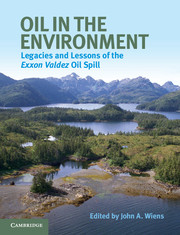Book contents
- Frontmatter
- Contents
- List of contributors
- Use of acronyms
- Acknowledgments
- A bibliographic note
- Prologue
- Part I Introduction and background
- Part II Oil in the environment
- 3 Oil in the water column
- 4 Surveying oil on the shoreline
- 5 Ancient sites and emergency response: cultural resource protection
- 6 Fate of oil on shorelines
- 7 Understanding subsurface contamination using conceptual and mathematical models
- 8 Removal of oil from shorelines: biodegradation and bioremediation
- Part III Biological effects
- Part IV Assessing oil spill effects and ecological recovery
- Part V Conclusions
- Index
- References
7 - Understanding subsurface contamination using conceptual and mathematical models
Published online by Cambridge University Press: 05 July 2013
- Frontmatter
- Contents
- List of contributors
- Use of acronyms
- Acknowledgments
- A bibliographic note
- Prologue
- Part I Introduction and background
- Part II Oil in the environment
- 3 Oil in the water column
- 4 Surveying oil on the shoreline
- 5 Ancient sites and emergency response: cultural resource protection
- 6 Fate of oil on shorelines
- 7 Understanding subsurface contamination using conceptual and mathematical models
- 8 Removal of oil from shorelines: biodegradation and bioremediation
- Part III Biological effects
- Part IV Assessing oil spill effects and ecological recovery
- Part V Conclusions
- Index
- References
Summary
Introduction
Petroleum spills and other sources of hydrocarbon contamination represent risks for society. Regardless of whether oil is stranded on a shoreline, spilled from a pipeline, or leaked from underground storage tanks, the same basic physical and chemical principles characterize exposure levels of contaminants. The purpose of this chapter is to explain and illustrate these principles. In particular, we use these principles to explain the apparent paradox of how oil residues persist at some shorelines of Prince William Sound (PWS) as isolated subsurface patches, but yet pose little if any exposure risk to the local ecology. We resolve this apparent paradox using well-established scientific and engineering tools.
One of the biggest challenges of any study of a contaminated site is identifying the most important questions and the most important observations and data needed to answer these questions. This challenge is discussed in this chapter in both a general way and for the PWS study in particular. One of the key lessons learned from this study was the need for experts in multiphase flow in contaminated sediments to be a central part of the team addressing these questions. Our goal is to convey a coherent understanding and perspective that brings all of the observations and measurements by various environmental experts of different scientific disciplines into a consistent explanation.
- Type
- Chapter
- Information
- Oil in the EnvironmentLegacies and Lessons of the Exxon Valdez Oil Spill, pp. 144 - 175Publisher: Cambridge University PressPrint publication year: 2013
References
- 2
- Cited by



